|
The Army of
Occupation in Bad Kissingen and the Rhoen - Grabfeld Region
In May 1945, the war in Europe ended and there were no fewer than
1.6 million US soldiers in Germany alone. The tasks at hand were
organizing those thousands of companies, battalions, batteries and
sections, divisions and corps for either continued war in the
Pacific or return to the United States and discharge from the
military. Woven throughout the redeployment period were the
missions associated with the formal occupation of Germany, something
for which the rank and file in the Army had received little or no
specialized training.
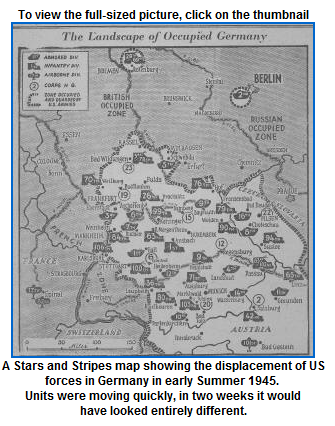
The steady slog of daily combat and advance changed, overnight to
standing guard at farm trail cross roads, checking the papers of
thousands of Germans and central Europeans and taking some into
custody, allowing others to pass and then simply waving vast groups
along the trails, guarding against the potential last of the Nazis
while controlling smuggling between the German states. In pens by
the major towns, captured Germans soldiers were collected and the
rations were always dangerously short. Selected units were fast
down the trail in search of Nazi technology while Army legal teams
poured over documents and created lists of significant war
criminals. There were so many American soldiers and so many
problems in Germany - the Summer of 1945 was a period of
anticipation slowly turning to discontentment.
Around Bad Kissingen and the Rhoen - Grabfeld region, the border
area that Eaglehorse troopers might recall, it was a busy Summer and
Fall. Here is our attempt to provide a glimpse of this part of the
story of the Americans, the Germans and Bad Kissingen.
The Fog of Peace
After a period of significant troop movement, adjustment and
readjustment in the Rhoen area, long after the 3rd Infantry Division
and the 14th Armored Division had stormed through, the dust had
settled by mid Summer and fragmentary evidence begins to turn up as
to specific units, locations and activities. This takes into
account those divisions of the VIII Corps that had attacked north -
northeast across the old German state lines of Bavaria into
Thuringia and then were in the vicinity of Meiningen.
The 99th Infantry Division had initial occupation responsibility in
the upper and lower Franconia region with the 79th Infantry Division
also moving into local assembly areas. Which other units followed
and their significant experiences is unknown. It was an extremely
fluid environment, almost all divisional histories of that era end
on the first official day of peace but now and then, a document
turns up and a stray battalion can be traced to a familiar town. It
might seem safe to say that the parent Combat Command, basically the
brigade combat mix, would have been nearby but this was not always
the case. Some units were consolidating for movement while others
remained spread across large geographic areas. One clue is that the
Military Government ( MG )Teams, so crucial in re establishing
immediate post war order to Germany, were generally matched to
divisions tasked with the first days of the occupation and this
single thread can lead to understanding troop dispositions.
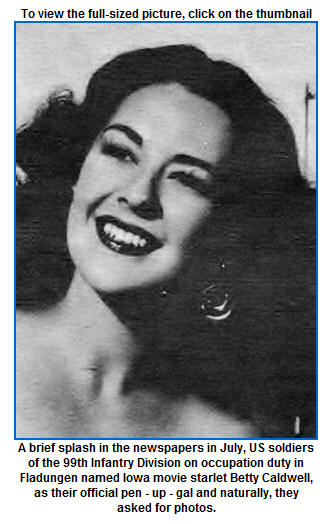
MG teams attached to the 99th Infantry Division fanned out to
Schweinfurt, Munnerstadt and team I2A3 led by a Captain Atwell,
moved into Bad Kissingen. But only a few miles to the north, MG
teams in Bad Neustadt and Meiningen, were attached to a different
and unidentified division. They may have been supported by the 79th
Division or some other unit, there is just no available evidence.
It was a Summer of great activity and some progress. The old state
border region between Hesse, Bavaria and Thuringia - what would
become the Cold War border, had been earlier discussed as a
convenient line between the Russians and Americans. US forces, in
the heat of the campaign, had penetrated as deeply as 250 KMs
intoThuringia and Prussia and when the fighting stopped, and
everyone caught their breath, certain readjustments were
necessary.
American forces that had ended the war and then remained in place
north of what was rapidly becoming more of a border and less of a
simple line on a map, were withdrawn south into Bavaria in mid
Summer 1945. The American military government teams that had been
stationed in Meiningen and similar surrounding towns, were likewise
withdrawn and control handed off to the Soviets. But this is not to
say that the Americans left empty handed. Whether it was the search
for looted art and Nazi science and technology, picking up war
criminals or just cleaning our the banks - the American Army insured
that the trucks were full as they headed south. The first sunny
days along the new border between the German states were marked by
handshakes, smiles, trading vodka for cigarettes and both Russian
and American MPs waving the military traffic through while trying to
first manage and then prevent the German population from following
the convoys out of the region.
For soldiers not otherwise engaged with the occupation missions of
security, civil control, or administrating to hundreds of thousands
of German POWs, and this was the vast majority of US forces,
commanders took up the available time with intensive unit sports
programs, inspections of men and equipment and, when all else
failed, sight seeing tours. The USO and Special Services Division
were active with entertainment and running excursions, anything to
divert troop attention from German women and venereal disease, a foe
portrayed as dangerous as the last German soldiers battling from the
final trench.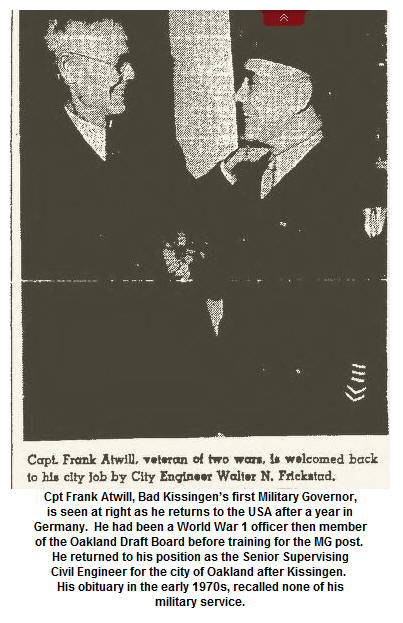
A Certain Clarity and
a First Mission at the Border
By mid Summer, references to specific units and missions can again
be found. The town of Bad Kissingen and the immediate surrounding
area was a 9th US Army Air Force responsibility. Rapidly shedding
the many fighter and bomber groups, logistics and maintenance units,
the Headquarters and Headquarters Squadron augmented by a huge staff
support section moved into the downtown area with their 926th
Signal Battalion and the IX Air Defense Command plus other
unidentified units in and around nearby Bad Neustadt. There may
have been other 9th AF units in the area, close aircraft squadrons
were identified in Schweinfurt and Wurzburg but references to the
926th Sig and IXth.ADA units are frequently found in multiple
sources.
The IX Air Defense Artillery Command was particularly active in
getting the names of soldiers receiving awards, as well as brief
articles recalling unit activities, into local US newspapers and
this example illustrates what probably was a common soldier
experience.
Iowa Globe Gazette
July 15, 1945
“PFC Charles Sorlien, son of Mr. and Mrs. Oscar C. Sorlien, 415
Georgia St. SE is at present stationed at Mellrichstadt, Germany
according to word received by his former associates in the
compositing room of the Globe - Gazette. He writes that he works on
a switch board from 8 until 11 each morning and during the same
hours at night. The rest of the time, he says, is his own. He says
he has seen Jack Benny at Schweinfurt and the Glenn Miller Band. He
has seen quite a bit of the countryside, going out in a jeep almost
every day. Some of his other spare time was used operating the
movie projector for the unit, he wrote. “
Other articles recalled the trips across Germany made by Lt Leslie
H. Mckensie, the 9th Army Air Force Reenlistment Officer as he
convinced draftees to consider Army careers and the efforts of 9th
ADA Command Chaplain, Floyd S. Smith, to help the locals in Bad
Neustadt reestablish a local synagogue.
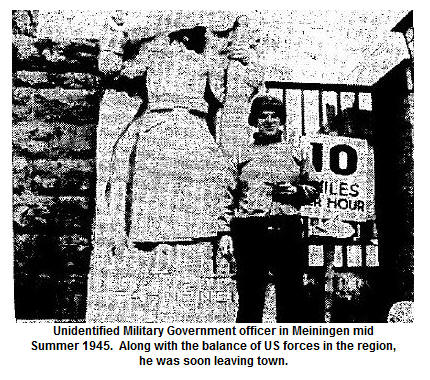
Beyond the newsprint, the 9th Air Force staff was tasked with a wide
variety of missions, everything from monitoring the weather and
reviving agriculture throughout the region to the search for
significant Nazi technology. On the one hand they were compiling
unit histories and disassembling the fighter and bomber commands and
across the hall - coordinating with German agencies as soon as they
could be stood up to insure some sort of transition from war to
peace without chaos or starvation in the immediate region.
Following soon into Kissingen some months later, with an interesting
back story all their own came staff units of the HQ XII Tactical Air
Command and although the evidence is sketchy, they may in fact have
established a local military school to retrain air personnel as MPs
to secure local areas and this begins to hint at how airmen became
occupiers in and around Kissingen in 1945.
We also find an interesting early snapshot of what was going on at
Manteuffel Kaserne on the hill above the town from about this time.
A personal recollection by a trooper assigned to a signal unit of
the XII Tac Air recalls that as his unit was being reconfigured,
they drew jeeps and trucks from a vast collection of vehicles lined
up in depot storage on the parade grounds of the barracks.
Apparently, as the 9th Air Force units departed Germany, their
vehicles and perhaps those from other units as well, were pooled at
Manteuffel and then made available to other units.
And then beyond the barracks gates, the first occupiers in the
countryside, the 99th Infantry Division soon departed for America
and assistance to the local MG teams became an ad hoc arrangement
probably informally tasked to the local air corps units. But the gap
was soon filled as units fully committed to the occupation mission
were identified.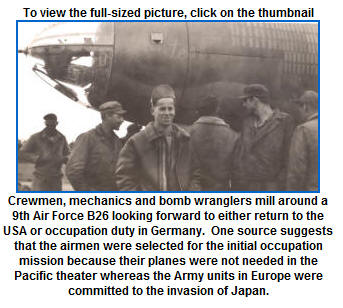
In October, the US occupation situation in the Rhoen - Grabfeld is
well documented. The 3rd Infantry Division was withdrawn from
northern Austria where it had ended the war and then spent the
Summer. After a very brief stay in the Frankfurt area, it received
a new mission to occupy portions of south central Germany, the same
general region it had fought through some months earlier. The
specific zone, the Main - Franken area, encompassed in the south,
Schweinfurt and Darmstadt and extended in a box as far north as the
city of Kassel. Even for an infantry division, this was a large
area to garrison.
Around Bad Kissingen and the near border region, the immediate tasks
fell to the 15th Infantry Regiment, then placed under the
operational control of the 1st Infantry Division, the next major
combat command dedicated to the occupation, located to the
southeast.
From this period, there are some known unit locations for the 15th:
Regimental Headquarters at Schweinfurt, Service Company at Wurzburg
and the Cannon Company at Maroldsweisach. The First Battalion was
at Wildflecken with D Company at Elsenfeld. The entire Second
Battalion was at Hammelburg. Third Battalion Headquarters was at
Mellrichstadt, Companies L and M garrisoned Koenigshofen, and then
continuing northwest along the border, K Company was located at
Ostheim and I Company moved into Fladungen. Interesting to see that
Bad Kissingen was not at all in the garrison plan. While airmen
may have ruled the city, the very first men to the border came with
few jeeps, rather, 2 ½ ton trucks and combat boots were the choices
at hand. The border was in the hands of the infantry.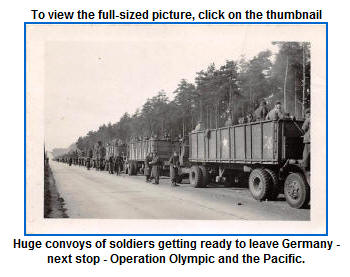
By the time the 3rd Battalion, 15th Infantry was in place north of
Bad Kissignen, they were not alone on the border. To assist in
Bavaria, the Americans had allowed a new civil Bavarian police
force to be established specific to the border area and this was
very much the work of the Military Government teams seeking German
solutions to German issues.
Retaining German police in the cities and towns had been an obvious
choice and required little effort but allowing a new force in the
border region was a significant step along the line towards an
official demarcation. These squads, consisting of former German
soldiers and armed with pistols, opened offices in dozens of
villages and towns along the border. Most offices were staffed by
small groups of ten or fewer men and were specifically to address
civil control in the border area. The Germans conducted many of
their patrols jointly with US occupation forces. And when it came
to actual strife along the border line, more often than not, it
involved German police based in the East and West - clashing. The
Russians had quickly responded with their own East German version of
a border police. With so many checkpoints and groups of smugglers
and displaced persons still on the move, and the border still
essentially open, clashes were bound to happen.
In the forests and rolling farm land that characterized the border
area north and east of Kissingen, the men of Companies L, M, K and
I would have spent much of their duty day in regular contact with
groups of wandering civilians. On the one hand were the refugees,
Germans who had for whatever reason, lost their homes or were
otherwise on the move. The second group was defined as displaced
persons. These DPs were homeless non Germans, streaming along roads
and trails after walking away from Nazi slave labor camps. Both
groups posed significant problems for the infantrymen who had
received no training for this mission.
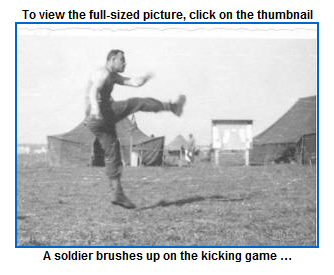
US Occupation Troops
in the Rhoen - Grabfeld and German Refugees
Clearly, most Germans feared occupation by Russians and with the
American zone so close, thousands were willing to become refugees
and abandon their homes and run to the south and west. The
Americans were hardly able to provide for the resident population
within their zone let alone allowing the numbers to swell by tens of
thousands. Likewise, the Russians, who were rapidly flushing German
populations out of Western Poland and similar regions, saw only
problems in rebuilding their zone of occupation if the native
population fled. Both sides agreed that the flow should stop.
The initial US policy was to apprehend and return to the East, those
who were trying to flee and in one of those twists of fate, senior
American officers speculated that Russian and American troops would
come to share the mission of keeping German refugees from fleeing
the Russian zone into Bavaria and Hesse. While numbers and other
hard evidence are hard to come by, it seems clear that for American
infantrymen and their German police counterparts from Fladungen to
Coburg, a common part of any day would have been asking for the
papers of Germans found on the run.
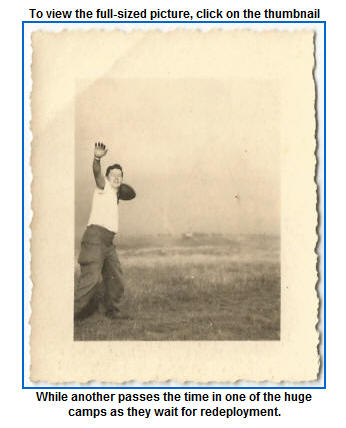
Initially, those civilians moving in the border area with the new,
American issued ID papers indicating some tie to the region, might
be allowed to move on and this was a boon to those who had gotten
their papers from American Government Teams in Thuringia prior to
the early July departure. Those without papers or with papers from
the Nazi period indicating their homes were in Thuringia, might be
taken into custody or, more probably, escorted back to the open and
frequently poorly marked border and ordered to march north under
penalty of arrest. So of these groups of hapless refugees who were
turned back - many ran into the woods and tried again.
In the early fall of 1945, some of the features that would come to
be associated with the border area came into existence. Both US and
Russian forces began to mark trees and wooden stakes with paint to
indicate the physical border. The Russians with their own newly
created East German border police began to close roads and trails
with barriers, set up guard shacks and run single or double strands
of barbed wire in open areas. The major road running north from Bad
Kissingen to Meiningen and crossing the border by Eussenhausen
remained open but under close supervision by American and Soviet
troops. There was some commerce along the normal roads but
Americans and Russians agreed that what was produced in the states
of Bavaria or Thuringia should not cross state lines. The refugee
steam was somewhat stemmed, and the border barrier system began.
Interestingly, at just about this period, the quality and
professionalism of the US soldiers in the region and in fact,
throughout Germany, began to deteriorate. The war with Japan had
ended and remarkably, the Army, under orders to begin a massive
reduction in costs and personnel, began to send to Europe, troopers
who had received only basic training. Units tasked with the
occupation mission came to consist of veterans who desperately
wanted to go home and recruits with at best, marginal training.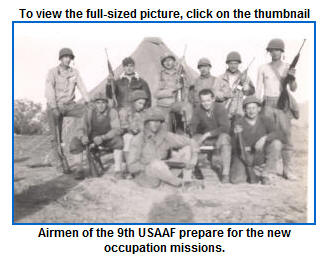
US policy towards fleeing Germans changed in 1946. Along the
border, the Russians were adding bunkers and guard shacks and
relations with the Soviets were becoming increasingly tense. By the
second year of the occupation, as American soldiers picked up
fleeing Germans in the border region, they turned them over to the
local border police officials as soon as possible. The Bavarian
Border Police reported that in 1946, they had encountered 481
people fleeing from the East in the Rhoen hills and apparently
allowed them to move on or had directed them towards relocation
assistance. This number is probably only a small fraction of the
number that slipped through uncounted. Along the entire German
border between east and west, by 1948, an accepted number is that
over 700,000 persons had fled to the west. As borders go, it was
well guarded and porous, at least when it came to the Americans.
Occupation Forces and
Displaced Persons
The second large group of people that members of the 15th Infantry
would have encountered while on occupation duty in the Rhoen in late
1945 and well into 1946 were part of the hundreds of thousands of
displaced persons wandering the countryside, primarily former slave
workers imported by the Nazis from the east into Germany during the
war and now adrift in the countryside. While refugees tended to be
found in small family groups, the DPs traveled in bands sometimes
numbering in the several hundreds. They clogged roads, there were
health and sanitation issues and incidents of revenge taking against
local Germans were not uncommon. The larger DP groups could even
create significant local crime waves. Many of these people had no
interest in returning to nations now occupied by Russians but they
had no where else to go.
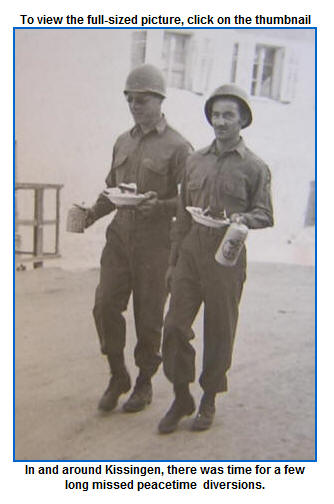
To deal with the problem, the Americans set up camps including a
huge one at the former Nazi barracks at Wildflecken and Army
humanitarian efforts in this regard can largely be summed up as:
round them up, ship them to camps, sort them out and then rail load
them home. Whether or not they wanted to return to the east was
not, at least initially, given much consideration. The Army’s
handling of the DPs was increasingly viewed as both ham handed and
sadly efficient in the pre Constabulary period.
Actual administration of the refugee camps was by 1947, handed off
to the International Refugee Organization that had moved its
headquarters into Bad Kissingen and this was a major turn in both
the politics of the problem and compassion towards the refugees.
Local camp police were formed, drawn from the throngs of DPs and
this freed the American Army from many of the dreary issues
surrounding the day to day guarding and administration of the camps
but even in the Constabulary period, massive raids by US forces on
the Wildflecken Camp were common in an effort to maintain order or
at least compliance of a population with no desire to return to the
East.
The IRO, to their great credit, worked tirelessly to resettle the
former slave laborers in the West if they refused to return to
countries now run by Communists and even West Germany, at the time a
minority share holder in the discussion, was not adverse to
regulated re settlement and offered a sort of second class
citizenship. American soldiers may have been the first camp guards
in 1945 but there were remaining echoes of this part of the
occupation mission well into the 1980s.
American troopers at Hohenfels, Grafenwoehr and Baumholder might
recall encountering personnel from range labor companies consisting
of middle aged men who spoke only Polish or Hungarian, while drawing
tents, targets or Saab target mechanisms. These men were the
residue of the thousands of displaced persons of the immediate post
war Germany. Having been allowed to remain through one of the
humanitarian programs and rather than being forced onto trains
heading east, these men were given a special status, neither
immigrant or resident, grouped into labor battalions and provided
jobs in support of the major American training areas. They labored
on until the end of the cold war coincided with their retirement and
the chance to return to the newly freed east or slip into the
German social safety net.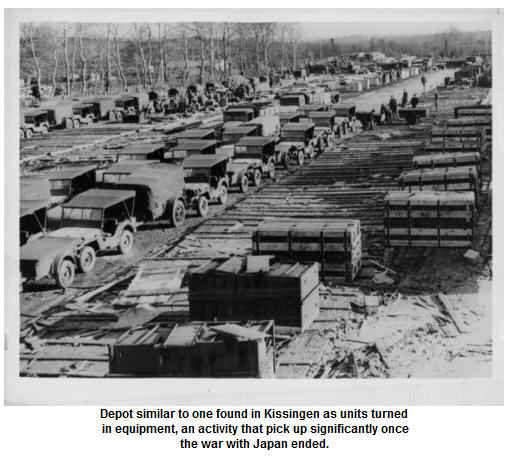
For the men of the Third Infantry Division and the 15th Regiment in
the Bad Kissingen border area, the occupation mission ended in mid
1946 with unit redeployment to the United States. There is very
little specific information related to these men and their
occupation period in the Rhoen. Historians agree, however, that on
the whole, in the last months of the occupation period, all across
Germany, American morale and trooper conduct suffered significant
breakdowns for a variety of reasons. The war was over - the
soldiers wanted to go home and there were other concerns.
The occupation forces were spread thinly over large geographic areas
and housed not really in barracks but in tents or commandeered local
German housing, this led to breakdowns in command supervision and
communications. There was a perceived lack of clear mission, poor
quality replacements, a lack of social services for the troops as
USO programs were cut back and unhappiness among the war veterans at
being retained in Germany for so long.
Many of the junior officers were likewise poorly trained or, had
returned to Germany after failing to find employment in the
peacetime economy. Due to boredom and a lack of active command
interest, there was excessive drinking, this led to rapes, shootings
and other crimes directed at local Germans who in turn, openly
brawled with American soldiers on pass. One of the regional hotbeds
for anti American sentiment during this period and an area noted by
significant unrest was in and around Coburg.
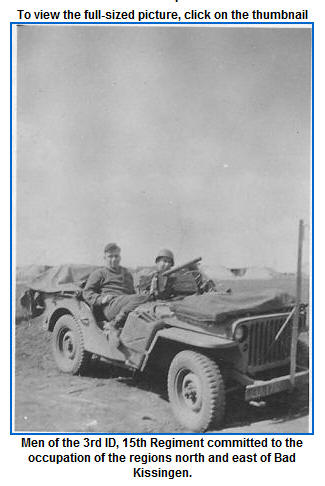
The very first Americans to the Rhoen border, flush with immediate
post war excitement, were faced with throngs of homeless people,
Germans, Czechs, Poles, Hungarians and countless others. There
were smugglers and Communists, POWs and peasants, wanderers in a
vast population on the move and an Army not well suited to the
mission. These units did their best to stand down from the combat
pace while taking on responsibilities for which they had no training
and all the while, the units were rapidly losing veterans to be
replaced by recruits. The scant evidence indicates the troopers by
and large did a credible job and when units began to break down on
the mission, they were soon given a much deserved return to the
United States.
Kissingen and then
the Border
At Kissingen, the 9th Army Air Force officially decamped with one
final awards ceremony on 1 December 1945. Select staff sections and
the HQ XII Tac Air remained for some further months before the last
hotel buildings in the town were returned to the German control and
the International Refugee Organization moved in to finally unsort
the many issues related to the displaced persons found in camps
across Bavaria and Hesse. The town and the barracks at Manteuffel
Kaserne were momentarily mostly free of Americans. But in the
fields and the hills to the north and east, there was that sound of
Jeeps running in the night, American soldiers with maps leaning
forward, peering down the trail and ready for what waited in the
darkness: anticipation, readiness and resolve.
The next to the border came forward with dash, élan and esprit de
corps. The next to the border in Rhoen - Grabfeld, were the
boisterous boys in jeeps with the Circle C Lightening Bolt insignia
of the US Army Constabulary.
Notes:
I have worked on this piece for months and keeping track of specific
notes for each fact / sentence was not fully done. The major source
points are listed below and if anyone wants a specific citation to a
sentence or paragraph, please contact Randy and I will try and
reconstruct the appropriate source.
US occupation of Meiningen and surrounding areas
Major source areas:
Come as Conqueror
Franklin M. Davis Jr.
Macmillan Press 1967
U.S. Army in the
Occupation of Germany
Earl F. Ziemke
Center of Military History
The American
Military Occupation of Germany
Oliver Frederiksen
United States Army Press 1953
Numerous period
newspaper and magazine accounts.
|